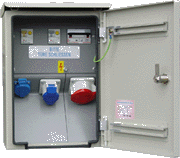Park & Charge
Park & Charge[1] is a European infrastructure for charging electric vehicles.
At reserved parking spaces for electric vehicles a simple, locked charging station with all necessary sockets and safety facilities is installed to which only "Park & Charge" users have access. Electric vehicles are in generally energy efficient, and therefore at a "Park & Charge" chargers requires relatively small quantities of electricity. By not having complicated metering technology and with the simplest organizational measures such as a (flat rate) cost, the administrative costs are kept low.
Park & Charge runs an open database LEMnet since 1998 that lists its own charging stations as well as that of other infrastructure providers in Europe.

- small Domestic socket-outlet (10–16 A, 250 V)
- CEE 16 A, 250 V
- CEE 16 A,400 V
History
In 1992, the first four locations of Park & Charge were established under the "pilot and demonstration project P & D" of the Federal Office of Energy in Bern. After a three-year experimental phase, the project went into regular operation. The Electromobile Club of Switzerland (ECS), which has accompanied the project, took over the financial and legal responsibility for Park & Charge. In the subsequent period Park & Charge became so popular that it needed to be legally formalised. At the end of 1997 Park & Charge was founded as an independent association (President: Wilfried Blum, Managing Director: Eduard Stolz).
Park & Charge stations became available beyond the borders as well. The German Solar Mobility Association founded an organization for the operation in Germany in 1997. Since 1999 there are Park & Charge stations in Italy and Austria. As for Austria VLOTTE has taken over the operations since 2010 which is a project by the "Vorarlberger Elektroautomobil Planungs- und Beratungs GmbH" in cooperation with the VKW Utility Company Vorarlberg (Vorarlberger Kraftwerke AG). More charging points became available in Liechtenstein, France and the Netherlands.
In the Canton Ticino the federal "P & D" project was continued with studies for „Veicoli Elettrici Leggeri“ (light electric vehicles) running from 1995 to 2001 (VEL1) and from 2001 to 2005 (VEL2). With the help of those projects an electric vehicle network of charging stations was deployed which is operated by RiParTI (Ricariche e Parcheggi in Ticino – Charging and Parking in Ticino).[2]
Function


The key, giving access to all the Park & Charge Charging in Europe.
The uniform logo for the whole of Europe and is used by law enforcement bodies for the simple identification of electric vehicles, and is dated 1 December of the previous year contribution period to 31 January the following year. Entitles the owners of Electric vehicles to use the specially marked and for reserved parking spaces.
The yearly subscription entitles the user use of all the Park & Charge Charging points in Europe at a (flat rate). The prices of the subscription is set by the respective national organizations.
Charging Stations
Today allows Park & Charge is at nearly 500 locations in Switzerland, Germany, Austria, the Netherlands and Italy, for drivers of electric vehicles, it is a safe and easy way to charge their cars battery.
LEMnet
The locations of the charging stations of Park & Charge were assembled in a list for its members. The list did also include charging sports of third parties as far as they were usable by the vehicle owners.
After the reorganization the new association created an internet database in 1998 to publish the list of available charging stations. The name LEMnet is derived from the main vehicle type of Park & Charge members at the time being light electric vehicles (LEV - in German Leichtelektromobile LEM) being electric quadricycles that are often summarized in English in the Neighborhood Electric Vehicle class. Those only need an electrical outlet to be charged overnight so that LEMnet did also list inns that cooperate with electric vehicle owners.
With the revival and mass production of electric vehicles the LEMnet database served as a central overview mapping the available charging stations across Europe. The providers of commercial charging station networks began to provide their data to LEMnet - in 2012 more than 30 providers cooperated with LEMnet. On 26 March 2012 it was decided form a new association to run the LEMnet database - the LEMnet Europe e.V.' is supported by Park & Charge and the E-Mobility Cluster, Mitteldeutschland.[3]
| time range | number of entries |
|---|---|
| until 2007 | 600 |
| until 2010 | 2800 |
| March 2012 | 3600 |
| October 2014 | 7200[4] |
See also
- Electric vehicle network
- German Solar Mobility Association
- Twike Club members were among the first users.
References
- ↑ Park & Charge website
- ↑ "Laden und Tanken RiParTI". InfoVEL Mendrisio. Retrieved 2012-04-01.
- 1 2 "LEMnet Europe e.V. gegründet." (PDF). 2012-03-27. Medienmitteilung. Retrieved 2012-03-31.
- ↑ "Entwicklung der Stromtankstellen - Infrastruktur in der DACH - Region am Beispiel der LEMnet Community" (PDF). 2014-10-29.
Getting connected, Electromobility and infrastructure. http://www.opi2020.com/images/4_Getting_connected_GB_040912.pdf
External links
- Park & Charge International
- Park & Charge Deutschland
- LEMnet, Internet database of electric vehicle charging stations in Europe
- LEMnet, Internet map of electric vehicle charging stations in Europe
- Website of Elektromobil Club der Schweiz (ECS)
- Bundesverband Solare Mobilität